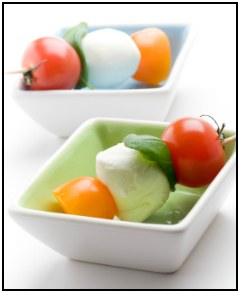 Whether in snacks or meals, most Americans struggle with portioning. Think about your favorite snacks. How often do we open a package and eat the whole thing?
Whether in snacks or meals, most Americans struggle with portioning. Think about your favorite snacks. How often do we open a package and eat the whole thing?The human brain takes cues about how much to eat from a number of different factors. How much everyone else is eating, how much is available and where the item falls in a line-up of other items all unconsciously count as much as how hungry we are (or even whether we're hungry at all). Our brains do not instantly register when we've reached our 'satisfied' or 'full' points, either. Building in pauses in our eating gives us a chance to realize we've had enough and stop.
Marketers often intentionally use size to their advantage when planning packaging; mostly to get us to eat more of things. We can use portioning equally intentionally to help control our budgets and our waistlines!
Here are a few simple ways to put portioning into practice in your kitchen:
1. Schedule time to break down bulk items. Whether you opt to do it immediately after getting home from grocery shopping or plan it into your weekly food prep routine, use baggies or small tupperware to portion out items purchased in bulk for easy access. Chips, veggies, cookies - it's much easier to stick to portioning when you do the work up front instead of while you're standing at the cupboard, hungry and browsing.
2. Focus on expensive & addictive items. Maybe you love good cheese, or maybe you pile fruit and nuts onto your oatmeal every morning. Whatever the expensive, addictive items are in your kitchen, you'll get the most bang for your buck by controlling your usage of them.
3. Use smaller dishes. Most contemporary dishes are enormous compared to those of fifty years ago. Try this experiment: if the proper portion size for cereal is one cup, measure out one cup of something into your bowl. What does it look like? Practically nothing, right? That's not a problem with the amount, it's a problem of skewed perspective caused by an over-sized bowl! Using smaller plates and bowls gives your brain better triggers as to how much you're eating. It also creates natural pauses, since you have to get up and refill your plate in order to eat more.
Hint: You don't necessarily have to buy new dishes - most sets come with salad plates and dessert bowls that are perfectly sized for properly portioned meals.
4. Pick foods with staying power. Although they may seem more expensive than some other choices, peanut butter, cheese, whole wheat crackers and other substantial, real-food snacks trigger the satiation chemicals in your brain fast and are digested slowly by your system, keeping you satisfied longer and avoiding sugar rush/ sugar crash cycles that only prompt additional eating. Calorie and cost-wise, you're better off with smaller portions of better quality snacks than eating more of the cheaper, less healthy options.
Do you utilize portioning in your frugal kitchen?
No comments:
Post a Comment